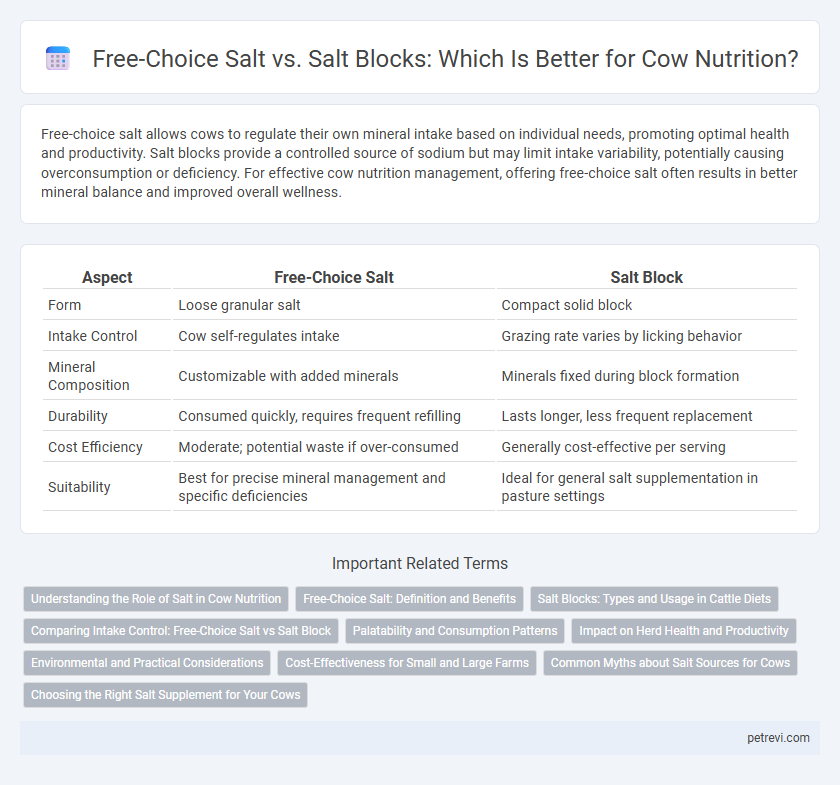Free-choice salt allows cows to regulate their own mineral intake based on individual needs, promoting optimal health and productivity. Salt blocks provide a controlled source of sodium but may limit intake variability, potentially causing overconsumption or deficiency. For effective cow nutrition management, offering free-choice salt often results in better mineral balance and improved overall wellness.
Table of Comparison
| Aspect | Free-Choice Salt | Salt Block |
|---|---|---|
| Form | Loose granular salt | Compact solid block |
| Intake Control | Cow self-regulates intake | Grazing rate varies by licking behavior |
| Mineral Composition | Customizable with added minerals | Minerals fixed during block formation |
| Durability | Consumed quickly, requires frequent refilling | Lasts longer, less frequent replacement |
| Cost Efficiency | Moderate; potential waste if over-consumed | Generally cost-effective per serving |
| Suitability | Best for precise mineral management and specific deficiencies | Ideal for general salt supplementation in pasture settings |
Understanding the Role of Salt in Cow Nutrition
Salt plays a crucial role in cow nutrition by regulating electrolyte balance, enhancing nutrient absorption, and supporting overall metabolic functions. Free-choice salt allows cows to self-regulate intake based on physiological needs, promoting optimal health and performance. Salt blocks provide a controlled salt source but may limit intake flexibility, potentially impacting feed efficiency and mineral balance.
Free-Choice Salt: Definition and Benefits
Free-choice salt is a mineral supplement provided separately, allowing cows to consume it voluntarily based on their individual nutritional needs. This feeding approach supports proper electrolyte balance, enhances feed intake, and promotes overall health by ensuring cows receive adequate sodium without risk of overconsumption. Compared to salt blocks, free-choice salt offers more precise regulation of intake, leading to improved weight gain and milk production in dairy and beef cattle.
Salt Blocks: Types and Usage in Cattle Diets
Salt blocks serve as a convenient and controlled way to provide essential minerals like sodium to cattle, enhancing hydration and overall health. Common types include plain white blocks, mineral-enriched blocks, and trace mineral blocks, each formulated to address specific nutritional needs in cow diets. Proper placement and monitoring of salt block consumption are crucial to avoid overconsumption and ensure balanced nutrient intake in cattle nutrition programs.
Comparing Intake Control: Free-Choice Salt vs Salt Block
Free-choice salt allows cows to self-regulate their sodium intake based on individual needs, reducing the risk of overconsumption and associated health issues. Salt blocks provide a fixed amount of salt in a solid form, which may limit intake control and lead to inconsistent consumption patterns among herd members. Monitoring intake is easier with free-choice salt as cows consume varying amounts, while salt blocks require observation to prevent excessive licking or complete avoidance.
Palatability and Consumption Patterns
Free-choice salt allows cows to regulate intake according to their individual needs, promoting natural consumption patterns and improving overall palatability. Salt blocks provide a consistent source of mineral intake but may lead to uneven consumption due to varying animal preference and hardness. Understanding cow behavior with each salt delivery method helps optimize mineral nutrition and maintain herd health.
Impact on Herd Health and Productivity
Free-choice salt allows cows to self-regulate sodium intake, supporting optimal hydration, digestion, and metabolic functions critical for maintaining herd health and boosting milk production. Salt blocks provide a controlled sodium source but may limit intake variability, potentially affecting nutrient balance and leading to uneven health outcomes across the herd. Properly managed free-choice salt supplementation enhances overall herd productivity by reducing metabolic stress and supporting immune function.
Environmental and Practical Considerations
Free-choice salt allows cows to self-regulate intake, reducing waste and environmental runoff compared to salt blocks that may lead to overconsumption. Salt blocks can cause uneven mineral distribution and increased soil salinity in concentrated areas, negatively impacting pasture quality. Selecting free-choice salt supports sustainable grazing practices by minimizing environmental impact and promoting animal welfare.
Cost-Effectiveness for Small and Large Farms
Free-choice salt allows cows to self-regulate intake, reducing wastage and potentially lowering overall feed costs, making it a cost-effective option for both small and large farms. Salt blocks offer a controlled, consistent salt source, but can be more expensive due to fixed consumption rates and replacement frequency, impacting large-scale operations significantly. Small farms may find free-choice salt more economically viable due to less need for frequent replenishment and easier monitoring of individual animal intake.
Common Myths about Salt Sources for Cows
Free-choice salt allows cows to self-regulate their sodium intake, promoting natural feeding behavior and preventing deficiencies, whereas salt blocks can limit consumption and reduce overall mineral intake due to hardness and weather exposure. Common myths suggest that salt blocks provide superior mineral delivery, but studies show free-choice loose salt improves uptake of essential trace minerals like zinc and copper, critical for immune function and growth. Incorrect assumptions about salt source efficacy can lead to suboptimal nutrition strategies, impacting cow health and productivity.
Choosing the Right Salt Supplement for Your Cows
Free-choice salt allows cows to self-regulate their intake, supporting natural feeding behavior and preventing mineral imbalances, while salt blocks provide controlled, consistent mineral intake with less waste. Selecting the right salt supplement depends on factors such as herd size, pasture mineral content, and individual cow needs, ensuring optimal nutrition and health. Evaluating soil mineral deficiencies and cattle production goals will guide effective supplementation, enhancing digestion, hydration, and overall performance.
Free-Choice Salt vs Salt Block for Cow Nutrition Infographic

 petrevi.com
petrevi.com